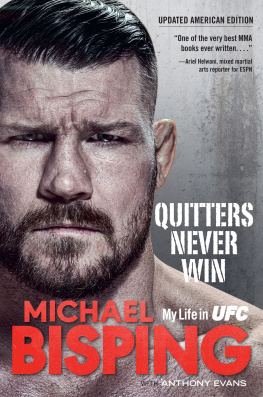WHY QUITTERS WIN
Decide to be Excellent
By Nick Tasler

Copyright Text
Published by Motivational Press, Inc.
2360 Corporate Circle
Suite 400
Henderson, NV 89074
www.MotivationalPress.com
Copyright by Nick Tasler
All Rights Reserved
w ww.nicktasler.com
No part of this book may be reproduced or transmitted in any form by any means: graphic, electronic, or mechanical, including photocopying, recording, taping or by any information storage or retrieval system without permission, in writing, from the authors, except for the inclusion of brief quotations in a review, article, book, or academic paper. The authors and publisher of this book and the associated materials have used their best efforts in preparing this material. The authors and publisher make no representations or warranties with respect to accuracy, applicability, fitness or completeness of the contents of this material. They disclaim any warranties expressed or implied, merchantability, or fitness for any particular purpose. The authors and publisher shall in no event be held liable for any loss or other damages, including but not limited to special, incidental, consequential, or other damages. If you have any questions or concerns, the advice of a competent professional should be sought.
Manufactured in the United States of America.
Hard Cover ISBN: 978-1-62865-000-6
Paperback ISBN: 978-1-93572-396-7
KNOW
THINK
DO
Introduction
The Curious Case of the Yellowstone Fire
When you come to a fork in the road, take it.
--Yogi Berra
On an overcast day in the middle of June 1988, Jim Barrett and two friends were driving up Daisy Pass on the northern edge of Yellowstone National Park when they spotted something. Off in the distance to their left, they saw two figures meandering aimlessly through a grassy, tree-lined meadow. As the pair got closer, Barrett realized that they were a man and his dog clad in scorched clothing and fur. Jim Barrett slowed his car to ask if the man was okay. When the stranger and his companion reached the vehicle, Barrett remembers thinking that the duo smelled like they had just rolled around in a campfire. He also noticed that the man needed first aid. Fast. Barrett and his friends tucked the strangers into the car and drove back down Daisy Pass into their hometown of Cooke City, Montana.
Along the way, the man explained that he had been camping at Yellowstone when he and his dog were completely overtaken by a raging fire they hadnt seen coming. With no other choice, the man hurried his dog to a nearby creek and leaped in. When the flames roared overhead, he held his dog under his arm beneath the surface of the frigid, mountain-fed spring until the blaze passed. With their camping supplies smoldering under a pile of ashes, they spent the night huddled together under a tree until the next morning, when they could finally begin hiking again. It was at that point when Barrett spotted them. Neither Barrett and his friends nor the stranger could have known then, but by the end of August, the Storm Creek Fire would join over 250 other fires. Collectively, the firestorm would end up transforming more than 1.5 million acres of Americas first National Park into a blazing inferno. It would cause public outrage from the Pacific Northwest all the way to the steps of Capitol Hill.
But the Yellowstone Fires of 1988 also did something else. They illustrated one of the most profound yet widely misunderstood lessons about the nature of excellence and the decisions that make excellence possible.
1. Let it Burn
The summer of 1988 began peacefully at Yellowstone National Park. Just like every summer before it for almost a century since Yellowstone became a national park, thousands of visitors each day flocked to the real-world home of Yogi Bear. Hoping for a brief escape from the fast-paced hustle of the daily grind, recreational campers, family vacationers, and nature-lovers all sought to lose themselves in the majestic pine trees. They wanted to breathe in the fresh mountain air and to catch an up-close glimpse of a bear, or maybe a wolf or an elk. Some would spend their days hiking through the woods, while others set out to try their luck with a fishing pole and a tackle box, while still others marveled at the wonder of the Old Faithful geyser. These were the things that Yellowstone National Park was all about in the summer months. Perhaps that explains part of the reason why the Storm Creek Fire that Jim Barrett had witnessed was conspicuously absent from Junes Daily Park Briefings for the Yellowstone ranger staff.
Instead, Junes briefing focused almost entirely on rather commonplace happenings such as bear sightings near camping trails, or on national news like the drought that was sweeping the nation. When lightning struck a lodgepole pine tree on the southwest edge of the Park and sparked another small fire a little more than a week after the Storm Creek Fire began in the north, the event went largely unnoticed by the parks rangers.
Finally, on the first day of July, the Yellowstone Daily Briefing noted that another fire was triggered near the pristine shores of Lake Lewis. Over 2,000 miles away in Washington D.C., National Parks Director William Mott received notice of what was happening at Yellowstone. Mott did nothing. He issued no order to extinguish the fires. Minute after minute, day by day, the flames crept through the forest, swallowing one tree after the next. Two weeks later, an approaching fire forced Vice President of the United States George H.W. Bush to cut short a backcountry fishing trip on the eastern edge of the Park. It wasnt until the week following the Vice Presidents return that Mott finally began ordering fire crews to contain the blaze. By then, however, it seemed to be too late. In spite of the valiant efforts of thousands of firefighters on the ground, in addition to helicopters and airplanes dousing the Park with water from the skies, the fires intensity only grew. On August 20, a day now referred to as Black Saturday, flames climbed more than 200 feet in the air and consumed over 150,000 acres of forest. More of Yellowstone National Park turned to ash on Black Saturday alone than the previous 100 years of wildfires combined. The Washington Post compared the carnage and chaos of Black Saturday to the attack on the U.S. air base in Da Nang, Vietnam.
The question that an outraged public, a skeptical Congress, and a critical media wanted answered was why didnt the Park Service stop it? More specifically, why didnt Bill Mott stop it ? Was Mott simply a pawn for a Reagan Administration whom Motts predecessor at the National Park System claimed had the most obscene environmental record in history? Or was the incident just another piece of evidence pointing to the ineptitude of government agenciesa tragic foreshadowing of the bungled government response to Hurricane Katrina two decades later? Or perhaps Bill Mott was just another career bureaucrat who had failed his way up into a leadership position and was destined to defy common sense when his nation needed him most?
While each question hinted at a plausible explanation, in fact, none was correct. There was another reason behind Bill Motts curious behavior that almost nobody considered. The real reason was so counterintuitive that it seemed patently absurd and illogical to the majority of people. The fact of the matter is too strange to be fiction: Extinguishing forest fires is an enormous fire hazard. Thats why Bill Mott adhered to a strict let it burn policy for forest fires within national parks.
2. The Paradox of Quitting
The late Bill Mott had a trim build with square shoulders and a white tuft of thinning hair. After declining President Nixons request to take command of the National Park Service in 1969, William Mott somewhat reluctantly agreed to take the post when it was offered to him again in 1985 by Ronald Reagan. By 1988, his distinguished career had made Mott the only 3-time winner of the Pugsley Medal, which honors the outstanding efforts of Americans who champion the cause of parks and conservation. Although nearing his 80 th birthday, William Motts wrinkled blue eyes and contagious smile still exuded the vigor that characterized his five decades of civil service. Mott had earned a reputation for being both a visionary and a pragmatic man of action with a relentless passion for protecting and expanding public spaces. During the last three decades of his life, it was generally accepted that if you cared at all about your public parks, Bill Mott was the guy you wanted taking care of them. It was that reputation that made his response to the Yellowstone Fires all the more puzzling. The confusion was widespread and included just about everyoneeveryone, that is, except for a handful of experienced, well-informed naturalists and ecologists.
Next page










